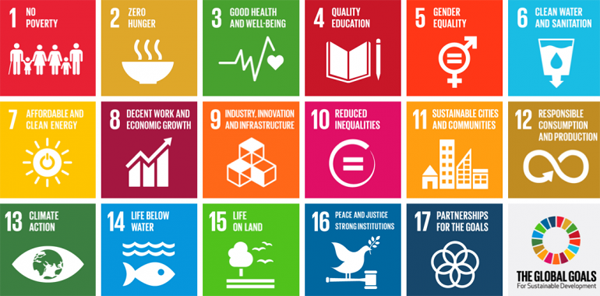Targets of other Sustainable Development Goals directly linked to health

Targets from Goal 3 focus on health and well-being, but the implementation of other Goals also benefits from or contributes to progress on Goal 3.
Goal 1. No poverty
- 1.5. By 2030, build the resilience of poor people and those in vulnerable situations, and reduce their exposure and vulnerability to climate-related extreme events and other economic, social and environmental shocks and disasters.
Goal 2. Zero hunger
- 2.2. By 2030, end all forms of malnutrition, including achieving, by 2025, the internationally agreed targets on stunting and wasting in children under 5 years of age, and address the nutritional needs of adolescent girls, pregnant and lactating women and older people.
Goal 4. Quality education
- 4.2. By 2030, ensure that all girls and boys have access to quality early childhood development, care and pre-primary education so that they are ready for primary education.
- 4.a. Build and upgrade education facilities that are child, disability and gender sensitive and provide safe, nonviolent, inclusive and effective learning environments.
Goal 5. Gender equality
- 5.1. End all forms of discrimination against all women and girls everywhere.
- 5.3. Eliminate all harmful practices, such as child, early and forced marriage, and female genital mutilation.
Goal 6. Clean water and sanitation
- 6.1. By 2030, achieve universal and equitable access to safe and affordable drinking-water for all.
- 6.2. By 2030, achieve access to adequate and equitable sanitation and hygiene for all and end open defecation, paying special attention to the needs of women and girls and those in vulnerable situations.
Goal 7. Affordable and clean energy
- 7.1. By 2030, ensure universal access to affordable, reliable and modern energy services.
Goal 8. Decent work and economic growth
- 8.7. Take immediate and effective measures to eradicate forced labour, end modern slavery and human trafficking, and secure the prohibition and elimination of the worst forms of child labour, including recruitment and use of child soldiers, and, by 2025, end child labour in all its forms.
- 8.8. Protect labour rights and promote safe and secure working environments for all workers, including migrant workers, in particular women migrants, and those in precarious employment.
Goal 9. Resilient infrastructure, inclusive and sustainable industrialization and innovation
- 9.1. Develop quality, reliable, sustainable and resilient infrastructure, including regional and transborder infrastructure, to support economic development and human well-being, with a focus on affordable and equitable access for all.
Goal 10. Reduced inequalities
- 10.7. Facilitate orderly, safe, regular and responsible migration and mobility of people, including through the implementation of planned and well-managed migration policies.
Goal 11. Sustainable cities and communities
- 11.2. By 2030, provide access to safe, affordable, accessible and sustainable transport systems for all, improving road safety, notably by expanding public transport, with special attention to the needs of those in vulnerable situations, women, children, people with disabilities and older people.
- 11.5. By 2030, significantly reduce the number of deaths and the number of people affected and substantially decrease the direct economic losses relative to global gross domestic product caused by disasters, including water-related disasters, with a focus on protecting poor people and people in vulnerable situations.
- 11.6. By 2030, reduce the adverse per capita environmental impact of cities, including by paying special attention to air quality and municipal and other waste management.
- 11.7. By 2030, provide universal access to safe, inclusive and accessible green and public spaces, in particular for women and children, older people and people with disabilities.
Goal 12. Responsible consumption and production
- 12.4. By 2020, achieve the environmentally sound management of chemicals and all wastes throughout their life cycle, in accordance with agreed international frameworks, and significantly reduce their release to air, water and soil in order to minimize their adverse impacts on human health and the environment.
Goal 13. Climate action
- 13.1. Strengthen resilience and adaptive capacity to climate-related hazards and natural disasters in all countries.
Goal 14. Life below water
- 14.2. By 2020, sustainably manage and protect marine and coastal ecosystems to avoid significant adverse impacts, including by strengthening their resilience, and take action for their restoration in order to achieve healthy and productive oceans.
Goal 15. Life on land
- 15.8. By 2020, introduce measures to prevent the introduction and significantly reduce the impact of invasive species.
Goal 16. Peace, justice and strong institutions
- 16.1. Significantly reduce all forms of violence and related death rates everywhere.
- 16.2. End abuse, exploitation, trafficking and all forms of violence against and torture of children.
Goal 17. Partnerships for the Goals
- 17.1. Strengthen domestic resource mobilization, including through international support to developing countries, to improve domestic capacity for tax and other revenue collection.
- 17.2. Developed countries to implement fully their official development assistance commitments, including the commitment by many developed countries to achieve the target of 0.7 per cent of ODA/GNI to developing countries and 0.15 to 0.20 per cent of ODA/GNI to least developed countries; ODA providers are encouraged to consider setting a target to provide at least 0.20 per cent of ODA/GNI to least developed countries.
- 17.9. Enhance international support for implementing effective and targeted capacity-building in developing countries to support national plans to implement all the sustainable development goals, including through North-South, South-South and triangular cooperation.
- 17.14. Enhance policy coherence for sustainable development.
- 17.19. By 2030, build on existing initiatives to develop measurements of progress on sustainable development that complement gross domestic product, and support statistical capacity-building in developing countries.



